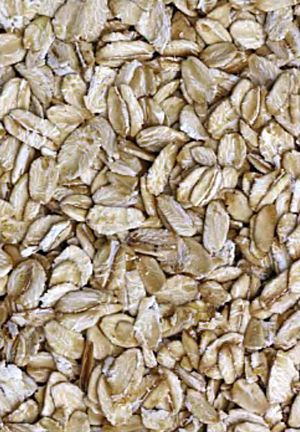Oat beta-glucan facts for kids
Oat beta-glucans are special types of fibers found in oats. They are a kind of soluble fiber, which means they can dissolve in water. These fibers are mostly found in the inner part of the oat kernel, called the endosperm. Oat beta-glucans are well-known for helping to lower bad cholesterol in your blood. Because of this, health organizations like the European Food Safety Authority (EFSA) and the US Food and Drug Administration (FDA) have said that eating oat beta-glucans can help reduce the risk of heart problems.
Contents
The Story of Oat Beta-Glucans
For hundreds of years, people have used oat products for health and beauty. But it wasn't until the 1900s that scientists really started to understand the specific role of beta-glucans. These fibers were first found in plants called lichens, and then in barley.
A scientist named Peter J. Wood, who started working for Agriculture and Agri-Food Canada in 1969, was very important in finding and studying oat beta-glucan. People became very interested in oat beta-glucan after it was reported in 1984 that it could help lower cholesterol.
In 1997, after looking at many studies, the FDA officially approved a health claim. They said that eating at least 3 grams of beta-glucan from oats each day, as part of a diet low in saturated fat and cholesterol, could help reduce the risk of heart disease. This was a big deal because it was one of the first times a government health group said that eating a specific food could directly help prevent a disease. This encouraged doctors and dietitians to recommend oats to help fight heart problems. Since then, eating oats has become even more popular for preventing diseases, not just for heart health, but also for helping with weight, blood pressure, and especially for lowering blood cholesterol.
How Oat Beta-Glucans Are Built
Cereal beta-glucans, which include those from oats, barley, and wheat, are long chains of sugar molecules. These chains are linked together in a special way. Most of these links are made of groups of three or four sugar units, connected by other links. In oats, beta-glucan is found mainly in the inner part of the oat kernel, especially in its outer layers. This is different from barley, where beta-glucan is spread more evenly throughout the kernel.
Most oats contain about 3-6% beta-glucan by weight. Farmers can even choose to grow specific types of oats that have higher levels of beta-glucan. Often, companies that process oats will only use types that have at least 4% beta-glucan.
Getting Beta-Glucans from Oats
Getting beta-glucan out of oats can be a bit tricky. This is because the beta-glucan molecules can break down easily, especially in very basic (high pH) conditions. So, scientists usually extract beta-glucan in conditions that are more neutral, and at temperatures between 60 and 100 degrees Celsius.
During the extraction process, beta-glucan often dissolves with some starch. The starch is then removed using a special enzyme. The remaining liquid might still have other plant parts like hemicelluloses and proteins. These can be separated out through other steps. By using methods like wet milling, sieving, and solvent-extraction, scientists can get oat beta-glucans that are up to 95% pure.
How Thick Oat Beta-Glucan Solutions Are
In oats, beta-glucan makes up most of the soluble fiber. However, if there's too much beta-glucan in a solution, it can become insoluble. How thick a beta-glucan solution is depends on how much of it dissolves, the size of its molecules, and the ratio of its sugar units. A thicker beta-glucan solution generally has more helpful effects on your body. For example, it can help lower blood sugar levels and cholesterol levels more effectively.
How Oat Beta-Glucans Affect Your Body
As a Helpful Fiber
Oat beta-glucans are a type of soluble, fermentable fiber. You might hear this called prebiotic fiber. This means they act like food for the good bacteria (called microbiota) in your large intestine. When these bacteria eat the beta-glucans, they produce helpful substances called short-chain fatty acids. These acids have many good effects on your body, including helping with digestion, how your body handles cholesterol and sugar, and even your immune system.
Lowering Cholesterol
In 1997, the FDA officially said that oat beta-glucan helps lower cholesterol. In Europe, the EFSA also agreed that eating beta-glucans helps keep blood cholesterol levels normal. They stated that there is a clear link between eating beta-glucans and "reduction of blood cholesterol concentrations."
To make this health claim, foods should provide at least 3 grams of beta-glucans per day from oats, oat bran, barley, or mixtures of these. This is especially helpful for adults who have normal or slightly high blood cholesterol.
In 2011, the European Union also allowed foods to say that oat beta-glucan is good for health. They said that if a food provides 3 grams of oat beta-glucan per day (or 1 gram per serving), it can state: "Oat beta-glucan reduces the cholesterol level in the blood. The lowering of the blood cholesterol level can reduce the risk of coronary heart disease."
Beta-glucan helps lower cholesterol partly by making the food in your small intestine thicker. This makes it harder for your body to absorb cholesterol. Studies also suggest it helps your body get rid of more cholesterol. The amount of cholesterol lowered can depend on the size of the beta-glucan molecules. Eating beta-glucan in liquid forms, like in juices, seems to be more effective at lowering cholesterol than in solid foods like bread.
Eating at least 3 grams of oat beta-glucan daily can lower total and low-density lipoprotein (LDL, or "bad") cholesterol levels by 5 to 10% in people with normal or high cholesterol.
Helping Digestion
As food moves through your digestive system, beta-glucan changes how thick the food mixture is. In your stomach, beta-glucans swell up, making you feel full. This can help reduce your appetite. In the small intestine, beta-glucan can slow down how quickly your body digests starch and absorbs sugar. This is important for keeping your blood sugar levels steady after you eat.
Oat beta-glucans also have a prebiotic effect. This means they help specific types of good bacteria grow in your colon. For example, they can help Lactobacillus and Enterococcus bacteria grow. Soluble beta-glucan also helps increase the weight of your stool by increasing the number of helpful microbial cells in your colon.
Managing Blood Sugar
Your blood sugar levels after a meal become lower when you eat foods containing beta-glucan. This happens because the beta-glucan makes the contents of your gut thicker, which slows down how quickly food leaves your stomach and moves through your small intestine. This means less sugar is absorbed into your blood at once. Studies have shown that this can lead to lower insulin levels and better insulin sensitivity.
A large review of studies in 2021 found that oat beta-glucan, especially larger molecules, significantly reduced how much blood sugar and insulin spiked after a meal. This was true for people with or without diabetes. People with diabetes who increased their daily beta-glucan intake by more than 3 grams for several months also lost some body weight.
Other Uses
Beta-glucan is also being studied for its potential to help with wound healing. It might help the body make new skin cells and heal tissues. It is also found in some creams and powders for skin care.
Images for kids







